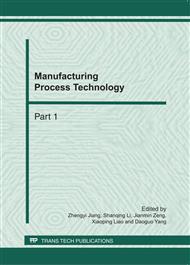p.1918
p.1922
p.1926
p.1930
p.1934
p.1941
p.1946
p.1955
p.1960
Study on Metal Flow in Continuous Extrusion Cladding of Cable Aluminum Sheath Using FEM Analysis
Abstract:
This paper analyzed continuous extrusion cladding process through 3D FE simulation in the non-steady state. The model is used to predict the metal flow characteristics during the entire process. According to the metal flow characteristic, continuous extrusion cladding process is classified into feeding, welding, filling and forming stages. The modeling results predict temperature, stress, strain rate and velocity fields. When the metal flows through the die bearing, the velocity distribution is non-uniformity, because of the non-symmetrical structure and the difference in temperature of the upper and bottom portion of the die cavity. And FEM results also show that the velocity distribution is sensitive to the change in mandrel radius. Increasing the mandrel radius can relatively improve the metal flow velocity in the upper cavity and decrease the velocity in the bottom cavity. There is an optimum mandrel radius value that makes metal flow most uniform. These also provide the theoretical basis for optimizing the technology and the die design.
Info:
Periodical:
Pages:
1934-1940
Citation:
Online since:
February 2011
Authors:
Price:
Сopyright:
© 2011 Trans Tech Publications Ltd. All Rights Reserved
Share:
Citation:


